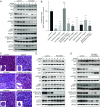Direct engagement of the PI3K pathway by mutant KIT dominates oncogenic signaling in gastrointestinal stromal tumor
- PMID: 28923937
- PMCID: PMC5635919
- DOI: 10.1073/pnas.1711449114
Direct engagement of the PI3K pathway by mutant KIT dominates oncogenic signaling in gastrointestinal stromal tumor
Abstract
Gastrointestinal stromal tumors (GISTs) predominantly harbor activating mutations in the receptor tyrosine kinase KIT. To genetically dissect in vivo the requirement of different signal transduction pathways emanating from KIT for tumorigenesis, the oncogenic KitV558Δ mutation was combined with point mutations abrogating specific phosphorylation sites on KIT. Compared with single-mutant KitV558Δ/+ mice, double-mutant KitV558Δ;Y567F/Y567F knock-in mice lacking the SRC family kinase-binding site on KIT (pY567) exhibited attenuated MAPK signaling and tumor growth. Surprisingly, abrogation of the PI3K-binding site (pY719) in KitV558Δ;Y719F/Y719F mice prevented GIST development, although the interstitial cells of Cajal (ICC), the cells of origin of GIST, were normal. Pharmacologic inhibition of the PI3K pathway in tumor-bearing KitV558Δ/+ mice with the dual PI3K/mTOR inhibitor voxtalisib, the pan-PI3K inhibitor pilaralisib, and the PI3K-alpha-restricted inhibitor alpelisib each diminished tumor proliferation. The addition of the MEK inhibitor PD-325901 or binimetinib further decreased downstream KIT signaling. Moreover, combining PI3K and MEK inhibition was effective against imatinib-resistant KitV558Δ;T669I/+ tumors.
Keywords: GIST; Kit; PI3K; mouse.
Conflict of interest statement
The authors declare no conflict of interest.
Figures








Similar articles
-
KIT over-expression by p55PIK-PI3K leads to Imatinib-resistance in patients with gastrointestinal stromal tumors.Oncotarget. 2016 Jan 12;7(2):1367-79. doi: 10.18632/oncotarget.6011. Oncotarget. 2016. PMID: 26587973 Free PMC article.
-
The V654A second-site KIT mutation increases tumor oncogenesis and STAT activation in a mouse model of gastrointestinal stromal tumor.Oncogene. 2020 Dec;39(49):7153-7165. doi: 10.1038/s41388-020-01489-4. Epub 2020 Oct 6. Oncogene. 2020. PMID: 33024275 Free PMC article.
-
Hedgehog pathway dysregulation contributes to the pathogenesis of human gastrointestinal stromal tumors via GLI-mediated activation of KIT expression.Oncotarget. 2016 Nov 29;7(48):78226-78241. doi: 10.18632/oncotarget.12909. Oncotarget. 2016. PMID: 27793025 Free PMC article.
-
The role of KIT in the management of patients with gastrointestinal stromal tumors.Hum Pathol. 2007 May;38(5):679-87. doi: 10.1016/j.humpath.2007.03.001. Hum Pathol. 2007. PMID: 17437861 Review.
-
Targeting c-kit mutations in solid tumors: scientific rationale and novel therapeutic options.Semin Oncol. 2001 Oct;28(5 Suppl 17):19-26. Semin Oncol. 2001. PMID: 11740803 Review.
Cited by
-
A novel c.2326G>A KIT pathogenic variant in piebaldism.Am J Transl Res. 2020 Oct 15;12(10):6501-6508. eCollection 2020. Am J Transl Res. 2020. PMID: 33194047 Free PMC article.
-
E3 ubiquitin ligase Atrogin-1 mediates adaptive resistance to KIT-targeted inhibition in gastrointestinal stromal tumor.Oncogene. 2021 Dec;40(48):6614-6626. doi: 10.1038/s41388-021-02049-0. Epub 2021 Oct 7. Oncogene. 2021. PMID: 34621020
-
Quantitative Phosphoproteomics Reveals System-Wide Phosphorylation Network Altered by Spry in Mouse Mammary Stromal Fibroblasts.Int J Mol Sci. 2019 Oct 30;20(21):5400. doi: 10.3390/ijms20215400. Int J Mol Sci. 2019. PMID: 31671542 Free PMC article.
-
Not all kidney cysts are created equal: a distinct renal cystogenic mechanism in tuberous sclerosis complex (TSC).Front Physiol. 2023 Nov 8;14:1289388. doi: 10.3389/fphys.2023.1289388. eCollection 2023. Front Physiol. 2023. PMID: 38028758 Free PMC article. Review.
-
Novel Germline KIT Variants in Families With Severe Piebaldism: Case Series and Literature Review.J Clin Lab Anal. 2024 Jun;38(11-12):e25073. doi: 10.1002/jcla.25073. Epub 2024 Jun 17. J Clin Lab Anal. 2024. PMID: 38887855 Free PMC article. Review.
References
-
- Hirota S, et al. Gain-of-function mutations of c-kit in human gastrointestinal stromal tumors. Science. 1998;279:577–580. - PubMed
-
- Huizinga JD, et al. W/kit gene required for interstitial cells of Cajal and for intestinal pacemaker activity. Nature. 1995;373:347–349. - PubMed
-
- Maeda H, et al. Requirement of c-kit for development of intestinal pacemaker system. Development. 1992;116:369–375. - PubMed
Publication types
MeSH terms
Substances
Grants and funding
LinkOut - more resources
Full Text Sources
Other Literature Sources
Molecular Biology Databases
Miscellaneous

